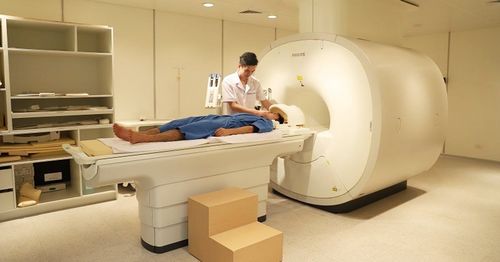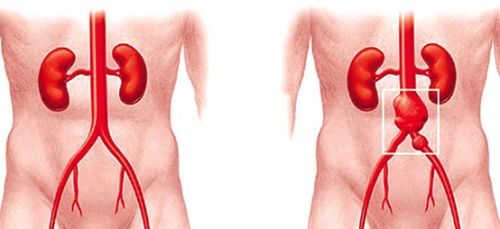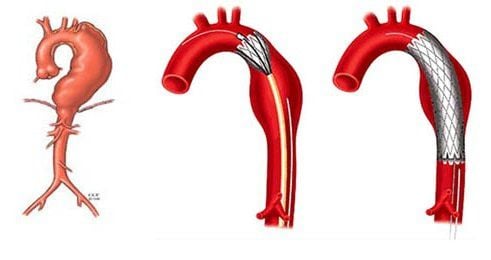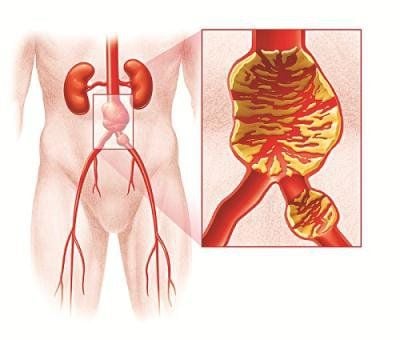This is an automatically translated article.
The article is professionally consulted by MSc Tran Hong Nhat - Interventional Cardiologist, Vinmec Central Park International Hospital.
An aortic aneurysm is a focal enlargement of the aorta in the form of a sac or rhombus, which is caused by a weak spot in the vessel wall. When the transverse diameter of the artery increases to more than 50% of its normal size, it is called an aortic aneurysm. The disease often has a multifaceted course, with a severe prognosis if not treated promptly.
Stent graft placement is one of the preferred methods of treating aortic aneurysms today.
1. What is stent graft placement?
Stent graft placement is an endovascular interventional treatment modality, ie intervention through a catheter. The technique uses a stent graft to exclude aneurysms, reduce the risk of rupture, and help correct anatomical flow in the lumen.
Applying stent graft technique in the treatment of aortic aneurysms helps shorten the time of surgery and hospital stay, and offers superior results compared to traditional surgical methods.
2. In which case is a stent graft placed?
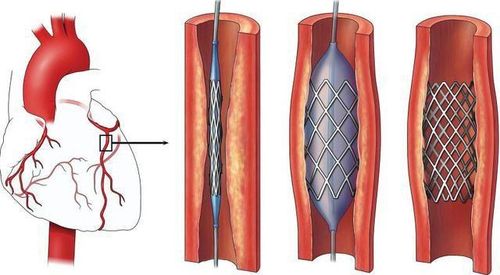
Indications for stent grafting intervention in the following cases:
Thoracic aortic aneurysm with diameter over 5.5cm (male) and over 5.0cm (female), or rapidly progressing over 5mm within 1 year and/ or complications of aortic dissection. Acute type B aortic dissection (access from descending aorta, within 2 weeks) has complications including: rupture of aorta into the pleural space, pericardial cavity, ischemia of organs, dilated arteries aorta, uncontrolled chest pain or uncontrolled severe hypertension Abdominal aortic aneurysm below the renal artery: diameter > 5.5 mm; or rapidly progressing over 5 mm/year; or have complications causing wall separation, threatened rupture... Pseudoaneurysm of the aorta after trauma or infection... Anatomical morphology suitable for stent graft placement: location of healing (dynamic area) the aorta adjacent to the lesion site) must be > 2 cm long and stable and undamaged to allow the stent graft tip to be attached to it. For the thoracic aorta, the distance from the lesion to the origin of the left subclavian artery is more than 2 cm. For an abdominal aortic aneurysm, the neck of the aneurysm (from the beginning of the aneurysm to the origin of the lowest renal artery) is > 1.5 cm. However, the following patient could not apply endovascular intervention:
Aortic dissection type A. ascending aortic aneurysm. Unresectable carotid artery dissection surgery. The pathological area is too close to major arterial branches for which there is no prior remedial plan. The patient has vascular disease that obstructs the entrance (femoral-pelvic artery disease,...). Uncontrolled infection. Blood clotting disorders...
3. How is stent grafting performed?
To conduct endovascular intervention, the patient needs to do computerized tomography of the thoracic and abdominal aorta to assess the damage and help the doctor make indications and plan appropriate interventions; In addition, the patient is also examined and tested to evaluate arterial damage as well as accompanying diseases. When the procedure is performed, the patient does not need to be anesthetized, but only receives local anesthesia in the groin area, where Stent graft is inserted at the correct lesion site under the guidance of the luminosity screen. Depending on the morphology and size of the damaged vessel, 1, 2 or 3 grafts can be placed; The intervention time is about 1-3 hours.
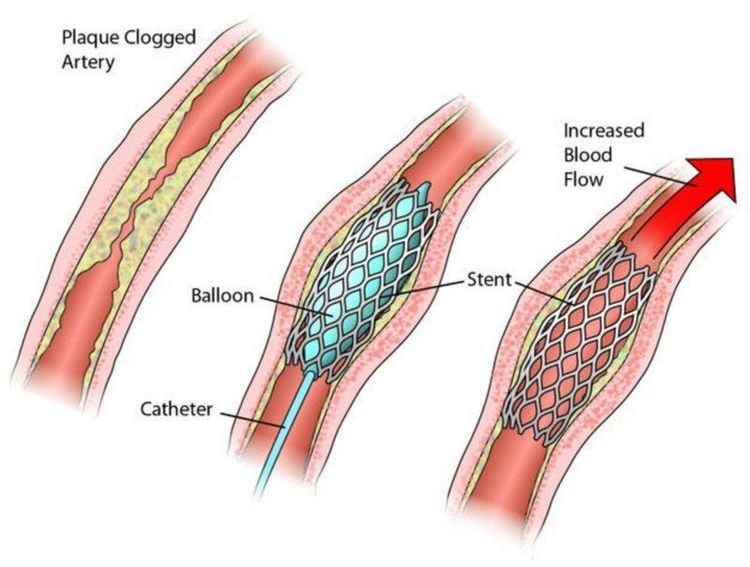
4. Follow-up after stent graft
After the intervention, the patient was hospitalized to monitor early complications of the procedure, with an average hospital stay of 2 - 3 days. Patients will be scheduled for routine check-ups after treatment for an aortic aneurysm. The patient was followed up by CT - scan to confirm the position of the stent in the aorta as well as no new lesions.
5. Where is the best place to perform stent grafting?
Vinmec International General Hospital is one of the few medical facilities that has implemented the stent graft technique to successfully treat large-sized aortic aneurysms in elderly patients with comorbid comorbidities.
Here, a team of highly qualified, experienced doctors are able to successfully perform endovascular intervention in the treatment of aortic aneurysms. In addition, Vinmec invests in the most modern machinery, equipment and facilities, with a Hybrid operating room equipped with DSA angiography machines, anesthesia machines with integrated hemodynamic monitoring software The tightest patient (PiCCO system, entropy,...), can meet the requirements of surgical treatment of arterial disease, including aortic stent grafting - a modern medical technique minimally invasive and safe, helping patients recover quickly with a shortened hospital stay.
In April & May 2021, when there is a need for medical examination and treatment at Vinmec Times City International General Hospital, customers will enjoy dual incentives:
- Free specialist examination and discount 50% of many cardiac checkup packages such as:
+ Basic Cardiovascular Screening Package
+ Hypertension Checkup Package
+ Heart Failure Checkup Package
+ Coronary Cardiovascular Examination Package
+ Comprehensive Cardiovascular Checkup Package
- 50 off % of cost for customers with post-examination treatment indications. The program is limited to the corresponding technique of each hospital and to customers who perform this treatment technique for the first time at Vinmec.
Please dial HOTLINE for more information or register for an appointment HERE. Download MyVinmec app to make appointments faster and to manage your bookings easily.





